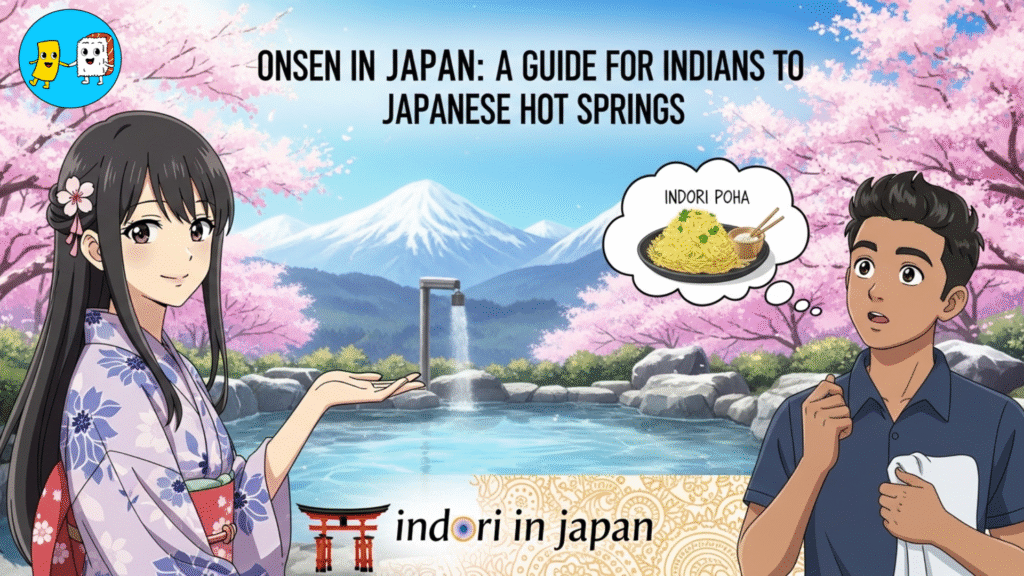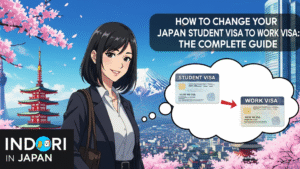The Ultimate Guide to Onsen in Japan: An Indian's A-to-Z Handbook to Soaking in Paradise
皆さん、こんにちは!(Hello everyone!)
Introduction: My First Onsen Experience – A Mix of Nerves and Nirvana
I’ll be honest. The first time I stood at the entrance of a Japanese onsen, I almost turned back. As an Indian living in Japan, I’ve embraced many new things—the food, the language, the mind-boggling train systems. But this? This was a whole new level of culture shock. The idea of getting completely naked in front of total strangers felt… well, it felt incredibly awkward. All the rules I’d heard about—wash here, don’t splash there, what do I do with the tiny towel?—were swirling in my head. Kya karu? What if I mess up and offend someone?
But I took a deep breath, walked through that curtain, and what I found on the other side was nothing short of magical. The moment I stepped into that steaming, mineral-rich water, surrounded by the quiet beauty of nature, all my anxieties melted away. It wasn’t just a bath; it was a profound sense of peace, a deep, bone-warming relaxation I had never experienced before. It was a moment of connection, not just with Japanese culture, but with myself.
That’s the onsen experience—a journey from nerves to nirvana. And that’s why I’m writing this guide. I know many of you, my fellow Indians and friends from around the world, feel that same mix of curiosity and hesitation. You’ve seen the beautiful pictures of snow-covered hot springs and heard about their healing powers, but the “how-to” part seems daunting.
Consider this your personal handbook. I’m here to be the friend who walks you through every single step, from understanding what an onsen actually is to mastering the etiquette like a local. My goal, as always with Indori in Japan, is to bridge the gap between our cultures and help you have the most amazing, authentic experiences. So, let go of the tension. By the end of this guide, you’ll be ready to take the plunge and discover your own moment of onsen nirvana.
What Exactly is an Onsen? (It's Not Your Bathroom's Hot Water!)
Before we dive into the rules and rituals, let’s clear up a common misconception. An onsen is not just any hot bath. It’s a specific, legally defined, and culturally significant part of Japan’s identity, deeply connected to nature, health, and history.
The Science and Soul of Onsen
In Japan, for a body of water to be officially called an onsen (温泉), it has to meet strict legal standards. The water must be naturally heated to at least 25°C at its source and contain at least one of 19 specific minerals, like sulfur, iron, or sodium chloride, in designated quantities. This is what makes it a tennen onsen (天然温泉), or “natural” hot spring.
This is the key difference between an onsen and a sento (銭湯). A sento is a public bathhouse that uses heated tap water. While sentos are a wonderful part of daily community life in Japan, onsens are considered a more special, therapeutic experience because of their natural, geothermally heated, mineral-rich waters.
The minerals are the soul of the onsen, and different types of water are believed to have different healing properties, a practice known as balneotherapy. For example:
- Sulfur springs (Iosen): Often found in places like Noboribetsu, these are said to be great for skin conditions and improving blood pressure.
- Bicarbonate springs (Tansan Suiso Ensen): Sometimes called “beautifying baths,” these are believed to soften the skin and cleanse pores.
- Chloride springs (Enkabutsusen): Known for their heat-retaining properties, these are thought to be effective for healing wounds and soothing muscle pain.
So, when you soak in an onsen, you’re not just getting warm; you’re bathing in a natural, therapeutic cocktail designed by Mother Earth herself.
A Tradition Older Than You Think
The history of onsen bathing in Japan is incredibly long, stretching back at least 1,300 years. It’s a tradition woven into the very fabric of the nation’s history and spirituality. In ancient times, onsen were seen as sacred places, gifts from the gods, and were often associated with Shinto and Buddhist purification rituals.
- Samurai would frequent hot springs to heal battle wounds and recover from fatigue.
- Buddhist monks used the waters for cleansing rituals before prayer.
- Emperors and nobles would make long journeys to famous onsen for their restorative powers.
This ancient practice of long-term therapeutic bathing, sometimes lasting for weeks to cure specific ailments, is known as tōji (湯治). While less common today, it highlights the deep-rooted belief in the onsen’s healing capabilities. It wasn’t until the Edo period (1603-1868), with the development of better transportation, that onsen trips became a popular form of leisure and social activity for the general public, evolving from purely medicinal sites to places of relaxation and community bonding.
A Buffet of Baths: Choosing Your Perfect Soak
One of the best things about onsen is the sheer variety of experiences available. Understanding the different types can help you find the perfect soak for your comfort level and desired atmosphere. The industry has thoughtfully evolved, creating options that cater not only to Japanese locals but also to international visitors who might be hesitant about the traditional communal setting.
- Rotenburo (露天風呂): This is the quintessential onsen experience you’ve likely seen in pictures—the outdoor bath. There is nothing quite like soaking in steaming hot water while surrounded by the beauty of nature, whether it’s a tranquil forest, a rushing river, or a majestic mountain view.
- Kashikiri-buro (貸切風呂): This is your golden ticket if you’re feeling shy, have tattoos, or are travelling with a partner or family. These are private, reservable baths, also known as kazoku-buro (家族風呂, family baths). You can book a time slot (usually for an extra fee) and enjoy the onsen all to yourself. This is a fantastic adaptation that makes the onsen experience accessible to everyone, acknowledging that the traditional model might not be comfortable for all cultures or individuals.
- In-Room Onsen: For the ultimate luxury and privacy, some high-end ryokan (traditional Japanese inns) offer rooms with their own private onsen, often on a balcony with a view. These are called Roten-buro-tsuki Kyakushitsu (“guestroom with an open-air bath”) and provide a truly special and intimate experience.
- Unique Variations: For a quick and casual taste, look for ashiyu (足湯), which are public foot baths, often free to use in onsen towns. For something truly different, some regions like Ibusuki offer sunaburo (砂風呂), where you are buried in naturally heated volcanic sand.
This variety demonstrates a wonderful flexibility within a deeply traditional culture. Japan wants you to experience this part of its heritage and has created pathways for you to do so in a way that feels comfortable and safe.
The Million-Dollar Question: When Do Japanese People Go to Onsen?
So, when is the best time to take a dip? The simple answer is: anytime! Japanese people enjoy onsen year-round, but the experience transforms dramatically with the seasons, making the “when” a strategic choice that balances scenery, crowds, and cost.
Soaking Through the Seasons
Each season paints the onsen landscape with a different brush, offering a unique kind of magic.
- Winter (December-February): The Ultimate Onsen Dream
This is, without a doubt, the most iconic and popular time for an onsen trip.17 The experience is called Yukimi-buro (雪見風呂), which literally means “snow-viewing bath”. Imagine this: you are submerged in a steaming outdoor rotenburo, your body enveloped in warmth, while the air around you is crisp and cold. Soft, white snowflakes drift down from the sky, blanketing the trees and rocks around you in a pristine layer of white. This incredible contrast between the hot water and the cold, snowy landscape is a peak Japanese experience—a moment of pure, serene beauty that feels like something out of a movie. It’s a sensory delight that warms you to the core. Because this is such a sought-after experience, be prepared for higher prices and the need to book accommodations well in advance, especially in famous onsen towns. - Autumn (October-November): A Symphony of Colours Autumn brings koyo (紅葉), the season of vibrant autumn leaves. Soaking in an outdoor onsen during this time means being surrounded by a breathtaking panorama of fiery reds, brilliant oranges, and golden yellows. The crisp air and the stunning foliage create a picturesque and deeply relaxing atmosphere, making it a favourite time for nature lovers and photographers.
- Spring (March-May): Bathing in Blossoms. In spring, the landscape is dominated by the delicate pink and white of sakura (cherry blossoms). An onsen experience during this period is poetic and beautiful, with the chance to soak while cherry blossom petals dance on the breeze and sometimes even float down into the water around you. It’s a fleeting, beautiful moment that captures the Japanese appreciation for the transient beauty of nature.
- Summer (June-August): The Refreshing Surprise. A hot bath in the middle of summer might sound counterintuitive, but it’s surprisingly delightful. Many onsen towns are located in mountainous regions where the altitude keeps the air cooler and less humid than in the cities. The true magic happens when you get out of the hot water. The warm air suddenly feels cool and refreshing against your skin, leaving you feeling invigorated rather than overheated. Plus, summer is generally considered the low season for onsen tourism, meaning fewer crowds and potentially lower prices—a perfect time for a more peaceful and personal retreat.
Choosing when to go is about defining your priority. If you crave that iconic snowy picture, winter is your goal, but plan for the cost and crowds. If you prefer solitude and are on a budget, a mountain onsen in summer could be your perfect escape.
The Daily Rhythm of Relaxation
On a day-to-day basis, the timing of an onsen soak is often about ritual and relaxation. The most popular time for Japanese people to visit an onsen is in the evening, before going to bed.26 A warm soak helps to relax tired muscles, ease the stresses of the day, and is widely believed to promote a deeper, more restful sleep.
If you’re staying at a ryokan, a typical onsen routine might look like this:
- A relaxing soak in the late afternoon upon arrival, before dinner.
- A delicious, multi-course kaiseki dinner.
- Another short soak before bed to ensure a good night’s sleep.
- An optional, invigorating dip in the early morning before breakfast to wake up the body and mind.
Naturally, the busiest times at a public onsen or a ryokan bath are just before and after dinner and breakfast. If you prefer a quieter experience, try going late at night or very early in the morning.
Onsen for Special Occasions
Onsen trips are a cornerstone of domestic tourism in Japan and a popular way to celebrate holidays and spend time with loved ones. This means that major national holiday periods are the busiest, most crowded, and most expensive times to visit an onsen town. These peak times include:
- New Year (Oshogatsu): Late December to early January.
- Golden Week: A collection of holidays from late April to early May.
- Obon: A festival to honour ancestors in mid-August.
During these periods, families gather for multi-generational trips, and even companies might organise retreats to onsen resorts, reinforcing the onsen’s role as a place for social connection and shared experience. If you plan to travel during these times, you must book your transport and accommodation many months in advance.
The Onsen Etiquette Masterclass: Your Step-by-Step Guide to Soaking Like a Pro
Alright, this is the part that can seem intimidating, but I promise it’s very simple once you know the flow. Think of it as a ritual with a few key steps designed to ensure everyone has a clean, peaceful, and relaxing experience. Let’s walk through it together.
Step 1: The Changing Room (Datsuijo)
Your journey begins here. You’ll find separate entrances for men and women, usually marked by curtains called noren. Look for the colour-coding and the kanji: blue and 男 (otoko) for men; red and 女 (onna) for women. Inside, you’ll find baskets or lockers. This is where you get completely naked. Yes, everything. Swimsuits are a strict no-go in traditional onsen. Place all your clothes and your large bath towel in the basket. The only thing you take with you into the bathing area is the small washcloth provided.
Step 2: The Washing Area (Araiba)
This is the single most important rule of onsen etiquette. Before you even think about touching the hot spring water, you must wash your body thoroughly. The bathing area will have rows of washing stations, each with a small stool, a faucet, a removable shower head, and complimentary soap and shampoo. Sit down on the stool—it’s considered rude to wash while standing, as you might splash your neighbours. Give yourself a proper scrub from head to toe. When you’re done, make sure you rinse off all the soap completely. The goal is to be squeaky clean before entering the communal water.
Step 3: Entering the Bath (Nyuyoku)
Now for the best part. Approach the bath and enter the water slowly and calmly. The water can be quite hot, often between 40°C and 44°C, so give your body a moment to adjust. Absolutely no jumping, diving, or splashing. The onsen is a sanctuary for relaxation, not a swimming pool.
Step 4: The Small Towel Conundrum
So, what do you do with that small washcloth? The one firm rule is that it must never touch the onsen water. You can place it on a rock at the side of the bath, but the classic, pro move is to neatly fold it and balance it on top of your head. It might feel a bit silly at first, but you’ll see almost everyone doing it. It keeps the towel clean and out of the way. You can also use it for a bit of modesty while walking between the washing area and the bath.
Step 5: The Art of Soaking
This is your time to relax. Find a comfortable spot and simply soak. If you’re with friends, you can chat quietly, but be mindful of others who are there for peaceful solitude. Keep your hair tied up so it doesn’t go into the water. It’s also important not to overdo it. A typical soak lasts for 5-15 minutes at a time. If you start to feel dizzy or too hot, get out, sit on the edge for a bit to cool down, and then get back in if you like.
Step 6: Exiting Gracefully
When you’re ready to leave the bath, don’t just walk straight into the changing room dripping wet. It’s good manners to use your small washcloth to gently wipe the excess water from your body before you step back into the dry changing area. The main drying is done in the changing room with the large towel you left in your basket.
Step 7: Post-Bath Bliss
Once you’re dry, it’s common practice not to rinse your body with tap water. The idea is to let the beneficial minerals from the onsen water remain on your skin to continue their work. The most important thing to do after your bath is to rehydrate. Drink plenty of water or tea. For a truly authentic post-onsen experience, try what the locals do: grab a bottle of cold milk, either fruit-flavoured (furutsu gyuunyuu) or coffee-flavoured (koohii gyuunyuu), from a vending machine in the lounge area. It’s surprisingly refreshing!.
Onsen Do's and Don'ts at a Glance
For a quick recap, here is a simple cheat sheet to help you remember the key points.
| DO ✅ | DON'T ❌ |
|---|---|
| Wash your body thoroughly at the washing station before entering. | Wear a swimsuit or any clothing into the onsen water. |
| Tie up long hair to keep it out of the water. | Let your small washcloth touch the onsen water. |
| Enter the bath slowly and calmly. | Jump, dive, splash, or swim in the bath. |
| Keep your voice low and be considerate of others. | Wash or scrub your body inside the onsen bath itself. |
| Place your small towel on your head or on the side of the bath. | Enter the onsen after drinking a lot of alcohol. |
| Gently wipe your body before returning to the changing room. | Take photos or use your phone in the bathing or changing areas. |
| Relax, enjoy the tranquillity, and rehydrate after your soak. | Stay in the hot water for too long if you start to feel dizzy. |
FAQs: Answering the Questions You're Too Shy to Ask
Even with a step-by-step guide, there are always a few tricky questions that can cause anxiety. Let’s tackle them head-on, because these “problems” are actually fantastic opportunities to understand Japanese culture on a deeper level.
The Tattoo Taboo: "Mere paas tattoo hai, kya karu?"
This is probably the biggest concern for international visitors. First, let’s understand the “why.” Historically, in Japan, tattoos were strongly associated with the yakuza, or Japanese mafia. The “no tattoos” rule was a way for establishments to keep organised crime members out. While this perception is slowly changing, especially with the influx of tourism, the ban remains in place at many traditional onsen.
But don’t worry, you have several great options:
- Book a Private Onsen: This is the easiest and most stress-free solution. Book a kashikiri-buro (privately reservable bath) or a hotel room with its own private onsen. This guarantees you access without any issues.
- Cover It Up: If you have a small tattoo, you can often cover it with a waterproof bandage or a special “tattoo cover sticker” which is available online or in some Japanese stores. This is often an acceptable solution, but it’s always best to check first.
- Find Tattoo-Friendly Onsen: More and more onsen are becoming explicitly “tattoo-friendly.” A quick search online can point you to facilities that welcome tattooed guests. For an up-to-date list, resources like the tattoo-friendly website are incredibly helpful.
- Always Check in Advance: The golden rule is to check the onsen’s policy on their website or call ahead to avoid any awkward situations at the door.
Health, Safety, and Other Things to Know
Here are a few final tips to ensure your onsen experience is safe and enjoyable:
- Stay Hydrated: The hot water can make you sweat more than you realise. Drink plenty of water before and after your bath to avoid dehydration.
- Avoid Alcohol: While a cold beer after a soak is great, bathing while intoxicated is dangerous. It can dehydrate you further and affect your blood pressure. Many onsen prohibit entry to heavily intoxicated individuals.
- Don’t Bathe on a Full Stomach: It’s best to wait at least 30-60 minutes after a large meal before getting in the onsen.
- Listen to Your Body: If you have high blood pressure or other health conditions, be cautious. Take shorter soaks and don’t make the water too hot. If you feel dizzy or unwell at any point, get out of the water immediately.
- On Menstruation: This is a sensitive topic. Traditionally, it was considered taboo for women to bathe during their period due to Shinto beliefs about purity. However, with modern hygiene products like tampons and menstrual cups, it is physically possible and is becoming more of a personal choice. There is no official rule, but it’s a matter of personal comfort and discretion.
The Onsen Dress Code: Embracing the Experience
The dress code for a traditional onsen is simple: your birthday suit. For many first-timers, this is the biggest hurdle. But think of it less as nudity and more as a uniform of equality. It’s a deeply respected cultural norm that is completely non-sexual. The simple truth is, everyone is in the same boat, and no one is paying attention.
This practice is rooted in the idea of “naked friendship” (hadaka no tsukiai), where everyone is equal in the restorative water. It’s a chance to connect with a core part of Japanese culture.
Still feeling hesitant? No problem at all. A fantastic alternative is the kashikiri-buro, a private onsen that you can book for yourself or your family. This way, you can ease into the experience comfortably without missing a drop of relaxation.
Conclusion: Your Invitation to the World of Onsen – Ek Dum Mast Experience!
So there you have it—your complete guide to the wonderful world of Japanese onsen. We’ve journeyed through its ancient history, uncovered its healing secrets, navigated the seasons, and mastered the step-by-step ritual of bathing. I hope that what once seemed like a confusing and intimidating custom now feels like an exciting and accessible adventure.
Remember, the onsen is so much more than just a hot bath. It’s a chance to press pause on the hectic pace of modern life. It’s an opportunity to connect with nature, with a deep and beautiful part of Japanese culture, and with yourself. The rules of etiquette are not there to trip you up; they are there to create a shared space of respect, cleanliness, and ultimate tranquillity for everyone.
Don’t let the fear of getting it wrong hold you back from what is truly one of the most incredible and rejuvenating experiences Japan has to offer. Take the plunge! Embrace the moment, soak in the peace, and I promise you, you will leave feeling refreshed in body, mind, and spirit. It’s an ek dum mast experience you will never forget.
For more official information on hot springs across the country, you can visit Japan Travel. And if you’re looking to deepen your understanding of Japanese language and culture to make your trip even more rewarding, check out my indoriinjapan.com—it’s a great way to start your journey!
Now, I want to hear from you! What are your biggest questions or fears about visiting an onsen? Or if you’ve already been, what was your experience like? Share your stories in the comments below!
✍️ Bonus: Need Help Starting?
✅ Job hunting tips and real listings for foreigners in Japan
✅ Visa guidance made simple—no confusing search
✅ Resume & cover letter templates (Japanese & English formats)
✅ Life in Japan explained — from rent to ramen
✅ Travel guides & city recommendations for every kind of explorer
✅ Work culture insights to help you adjust and thrive






2 thoughts on “Onsen in Japan: A Guide for Indians to Japanese Hot Springs”
それはいいですね。日本のママたちと温泉に早く行けたらいいな…
良いね。私もこれが欲しいです。